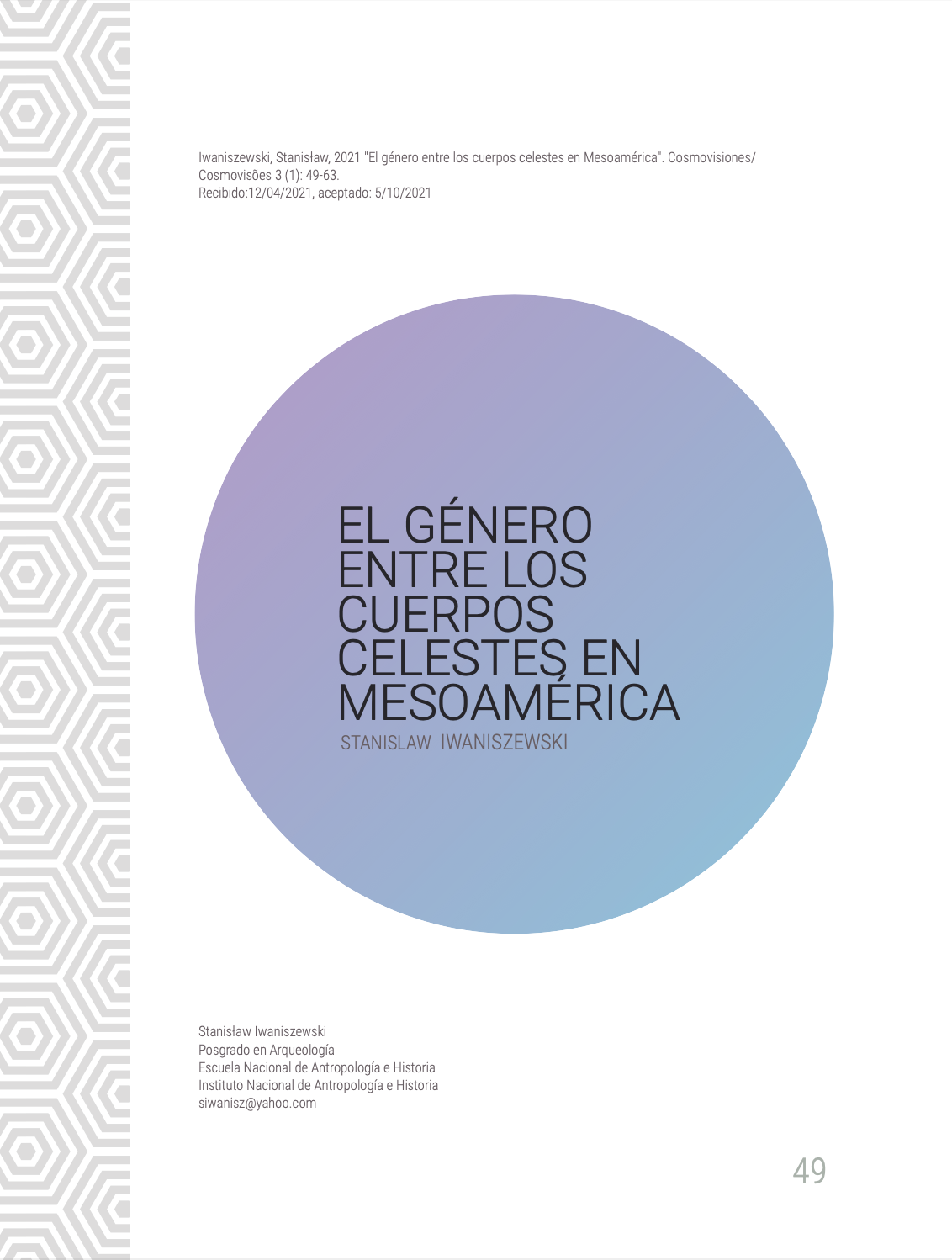El género entre los cuerpos celestes en Mesoamérica
Palabras clave:
Género cuerpos celestes, MesoaméricaResumen
En el pensamiento tradicional mesoamericano, el sol, la luna y venus, los tres objetos más brillantes del cielo, figuran como seres autónomos dotados de poder de actuar. A partir de la observación de sus movimientos en el cielo, los pueblos mesoamericanos dotaron a los astros de las formas culturales semejantes a las de los humanos – género, parentesco, lenguaje, sistemas de intercambio, etcétera. A su vez esto permitió a los astros comportarse bajo preceptos y normas sociales humanas. De esta manera, los tres astros, cuya presencia era importante para las actividades agrícolas, desempeñaron un papel esencial para representar las relaciones entre las sociedades y culturas mesoamericanas y su entorno.
En el artículo se recalca la percepción de los tres astros como seres sexuados. Se observa que el Sol se percibe como un agente masculino, la Luna – como un agente femenino y el planeta venus como un agente masculino, tanto en su aspecto de la Estrella de la Mañana como de la Estrella de la Tarde [...]
Referencias
Aguilera, Carmen 2001 The Mexica (Aztec) Milky Way. En: Astronomy, Cosmology and Landscape, editado por Clive Ruggles, Frank Prendergast y Tom Ray, 127-132. Ocarina Books, Bognor Regis.
Báez-Jorge, Félix 1983 La cosmovisión de los zoques de Chiapas (Reflexiones sobre su pasado y su presente). En: Antropología e historia de los mixezoques y mayas (Homenaje a Frans Blom), editado por Lorenzo Ochoa y Thomas A. Lee, Jr., 383-437. IIAUNAM-Brigham Young University, México.
Bourdieu, Pierre 1977 Outline of a Theory of Practice. Cambridge University Press, Cambridge.
Bourdieu, Pierre 1991 El sentido práctico. Taurus, Madrid.
Bourdieu, Pierre y Loïc J.D. Wacquant 1995 Respuestas: Por una antropología reflexiva. Siglo Veintiuno, México.
Brague, Rémi 2003 The Wisdom of the World. The Human Experience of the Universe in Western Thought.The University of Chicago Press, Chicago.
Chinchilla Mazariegos, Oswaldo 2011a Los soberanos: la apoteosis solar. En: Los mayas: voces de piedra, Alejandra Martínez de Velasco y María Elena Vega (coords.), pp. 265-275.
Ámbar Diseño, México. 2011b Imágenes de la Mitología Maya. Museo Popol Vuh, Universidad Francisco Marroquín, Guatemala.
Descola, Philippe 2012 Más allá de naturaleza y cultura. Amorrortu, Buenos Aires.
Espinosa Pineda, Gabriel 2008 El aspecto masculino del arcoíris prehispánico. Cuicuilco 15(43): 159-184.
Estrada Belli, Francisco 2011 The First Maya Civilization: Ritual and Power before the Classic Period. Routledge, London & New York.
Farris, Nancy M. 1987 Remembering the Future, Anticipating the Past: History, Time, and Cosmology among the Maya of Yucatan. Comparative Studies in Society and History, 29, 3: 566-593.
Fields, Virginia M. y Dorie Reents-Budet, eds. 2005 Mayas, señores de la creación. Editorial Nerea, San Sebastian.
Galinier, Jacques 1990 La mitad del mundo, cuerpo y cosmos en los rituales otomíes. UNAM-INI, México.
Guiteras Holmes, Calixta 1996 Los peligros del alma: visión del mundo de un tzotzil. Fondo de Cultura Económica, México.
Graulich, Michel 1980 Mythes et rites des vingtaines du Mexique Central Préhispanique, Thèse présentée pour l’obtention du grade de Docteur en Philosophie et Letres, Université Libre de Bruxelles.
Habermas, Jürgen 2008 Teoría de la acción comunicativa, II. Taurus, México.
Hunt, Eva 1977 The Transformations of the Hummingbird. Cornell University Press, Ithaca & London.
Iwaniszewski, Stanisław 1992 On some Maya Chol Astronomical Concepts and Practices. En: Readings in Archaeoastronomy, editado por S. Iwaniszewski, State Archaeological Museum, Warsaw University, Warszawa, 131-134.
Iwaniszewski, Stanisław 2005 Venus in the East and West. Archaeoastronomy, The Journal of the Center for Archaeoastronomy, vol. 12&13:151-162.
Iwaniszewski, Stanisław 2009 Por una astronomía cultural renovada. Complutum 20, 2: 23-37.
Iwaniszewski, Stanisław 2011 The sky as a social field. En: Archaeoastronomy and Ethnoastronomy: Building Bridges between Cultures. [Proceedings of the International Astronomical Union, 278], editado por Clive L.N. Ruggles.30-37. Cambridge University Press, Cambridge.
Iwaniszewski, Stanisław 2016 They Were Like Them: The Stars in Mesoamerican Imagery. En: Heavenly Discourses, editado por Nicholas Campion, 51-59. Sophia Centre Press, University of Wales, Trinity St. David, Ceredigion.
Kameneckiy,I.S., B.I. Marshack, J.A. Sher 1975 Analiz arkheologicheskikh istochnikov (The analysis of archaeological findings). Nauka, Moskva.
Latour, Bruno 2008 Reensamblar lo social. Una introducción a la teoría del actor-red. Manantial, Buenos Aires.
Lévi-Strauss, Claude 2008 El sexo de los astros. En: Antropología estructural, Siglo XXI editores, México (primera edición en español, 1979), pp. 203-211.
López Austin, Alfredo 1994 Tamoanchan y Tlalocan. Fondo de Cultura Económica, México.
Lunes Jiménez, Elena 2011 El ch’ulel en los Altos de Chiapas: estado de cuestión. Pueblos y fronteras 6, 11: 218-245. Revista digital consultada el 13 de noviembre del 2015.
Luppo, Alessandro 1991 La etnoastronomía de los huaves de San Mateo del Mar, Oaxaca. En: Arqueoastronomía y etnoastronomía en Mesoamérica, editado por Johanna Broda, Stanislaw Iwaniszewski y Lucrecia Maupomé, 219-233. IIH, UNAM, México.
Miller, Arthur G. 1986 Maya Rulers of Time. University Museum, University of Pennsylvania, Philadelphia.
Milbrath, Susan 1995 Gender and Roles of Lunar Deities in Postclassic Central Mexico and Their Correlations with the Maya Area. Estudios de Cultura Nahuatl, 25: 45-93.
Milbrath, Susan 1999 Star Gods of the Maya. University of Texas Press, Austin.
Page Pliego, Jaime Tomás 2001 Construcción de la noción de persona entre los tzotziles de San Juan Chamula y Pedranos de Chenalhó, Chiapas. Pueblos y fronteras 1: 25-55
Pascual Soto, Arturo y Erik Velásquez García 2012 Relaciones y estrategias políticas entre El Tajín y diversas entidades mayas durante el siglo IX d.c. Contributions in New World Archaeology 4: 205-227.
Soustelle, Jacques 2004 El universo de los aztecas. Fondo de Cultura Económica, México. (1ra edición en español 1982)
Stresser-Péan, Guy 2009 The Sun God and the Savior. The Christianization of the Nahua and Totonac in the Sierra Norte de Puebla, Mexico. University Press of Colorado, Boulder.
Strubblefield, Morris y Carol Strubblefield 1969 The History of Lay and Gisaj: A Zapotec Sun and Moon Myth. Tlalocan 6(1): 47-62.
Tate, Carolyn 1999 Writing on the face of the moon: women’s products, archetypes, and power in ancient Maya civilization. En: Manifesting Power: Gender and the interpretation of power in archaeology, editado por T.L. Sweely, 81-192. Routledge, London y New York.
Taggart, James 1983 Nahuat Myth and Social Structure. University of Texas Press, Austin.
Tedlock, Barbara 1992 Time and the Highland Maya. revised ed., University of New Mexico Press, Albuquerque.
Thompson, J. Eric S. 2006 Historia y religión de los mayas. Siglo Veintiuno, México. (primera edición en español 1975).
Watanabe, John M. 1983 In the World of the Sun A Cognitive Model of Mayan Cosmology. Man, N.S. 18(4): 710-728.
Velásquez García, Erik 2009 ‘Los vasos de la entidad política de ‘Ík’: una aproximación histórico-artística. Estudio sobre las entidades anímicas y el lenguaje gestual y corporal en el arte maya clásico’. Tesis doctoral. Universidad Nacional Autónoma de México.
Velásquez García, Erik, Jesús Galindo Trejo, Stanislaw Iwaniszewski 2011 La astronomía. En: Los mayas: voces de piedra, Alejandra Martínez de Velasco y María Elena Vega (coords.), pp. 127-149. Ámbar Diseño, México.
Vogt, Evon Z. 1997 Zinacanteco Astronomy. Mexicon 19(6): 110-117.

Descargas
Publicado
Número
Sección
Licencia
Los autores que publican en esta revista están de acuerdo con los siguientes términos:
Los autores conservan la autoría intelectual del trabajo y garantizan a la revista el derecho de ser la primera publicación del trabajo.
Los autores pueden compartir el trabajo con un reconocimiento de la autoría y la publicación inicial en esta revista.
Los autores pueden establecer por separado acuerdos adicionales para la distribución no exclusiva de la versión de la obra publicada en la revista (por ejemplo, situarlo en un repositorio institucional o publicarlo en un libro), con un reconocimiento de su publicación inicial en esta revista.
La revista ofrece acceso libre ("open access") a todo su contenido. Los artículos se encuentran disponibles para ser leídos, descargados, copiados, impresos y/o investigados de acuerdo a la licencia Creative Commons: CC BY-NC-SA (Atribución - No Comercial - Compartir Igual-4.0 Internacional)

El contenido de la revista queda completamente disponible a partir de su publicación. Los lectores tienen por obligación citar correctamente a la revista y al autor del contenido descargado















